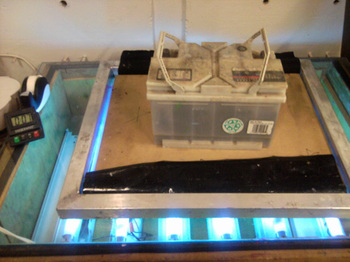Originally published 12/16/2011
Here is our $60 homemade exposure unit kicking ass . . . the battery we place on top while exposing the screens gives it that extra 12v you need (actually 40lbs). The idea when exposing, of course, is to eliminate any space between the film and the screen for the best detail. When you don't have enough contact the screen can become fuzzy and, therefore, unprintable. People spend hundreds to thousands of dollars on special exposure tables or vacuum units, but really all you need, like we explained previously, is a dark cloth, a piece of wood cut to the screens' size, and something like the battery to get a great exposure. We can get halftone detail in 30 seconds!
One note to the printers out there: the cold weather really makes washout tough. You might want to cut back your exposure times a bit.
Here is our $60 homemade exposure unit kicking ass . . . the battery we place on top while exposing the screens gives it that extra 12v you need (actually 40lbs). The idea when exposing, of course, is to eliminate any space between the film and the screen for the best detail. When you don't have enough contact the screen can become fuzzy and, therefore, unprintable. People spend hundreds to thousands of dollars on special exposure tables or vacuum units, but really all you need, like we explained previously, is a dark cloth, a piece of wood cut to the screens' size, and something like the battery to get a great exposure. We can get halftone detail in 30 seconds!
One note to the printers out there: the cold weather really makes washout tough. You might want to cut back your exposure times a bit.


 RSS Feed
RSS Feed
